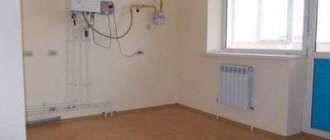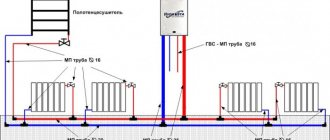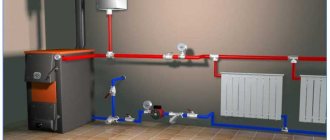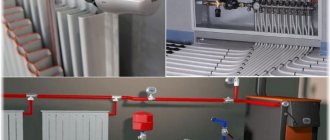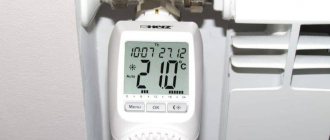Many of those who received receipts for services this year were very surprised at how impressive the amounts for heating turned out to be. Of course, when you designed the heating of an apartment and installed heating in a gas-type apartment, it was understood that the main costs would be only the installation of the system. Not long ago, new rules were established that explain the calculation of heating in an apartment. In addition, another additional line appeared in the receipt - ONE heating.
Apartment heating calculation
In this article we will help you determine how heating in an apartment is calculated. According to the new rules and standards of calculation, payment for any utility service, including heat energy, will be divided into several parts: payment for services provided in the residential premises, and payment for services provided for the general needs of the entire house. For this reason, the heating receipt will now have not only one line, but two.
Calculation
The procedure for calculating the heating bill will depend entirely on how the house is heated and what heating devices are installed in the room. There are several basic options for equipping a home with devices and appliances, which largely determine how heating in an apartment is calculated:
- In a residential building, only one device is installed, which is common, and in apartments and non-residential premises there are no metering devices at all.
- The house has a common device, which is needed to account for heating, but also individual rooms in the house are equipped with individual devices.
- The house completely lacks a common heating meter.
One of the options for installing a heat metering device
First of all, you need to find out if there is one common household appliance installed in the house, and also whether there are other individual heating metering devices in residential or non-residential premises.
Calculation methods
In recent years, the principle of calculating heating charges has changed several times. Since 2012, the fees have been determined according to Resolution 345
Government of the Russian Federation. At a certain period of time, payment for thermal energy used for general house needs was introduced - the calculation was carried out separately from heating supplied directly to apartments. Later, in 2013, these payments were again combined into one.
New calculation
introduced from 2021, using several different formulas.
First of all, you need to figure out which formula
is used in a particular case.
It is also important to know how your home is charged - only during the heating season or all year round. In the Russian Federation, both resolutions have equal force: No. 354 on charges only during the heating season, and No. 307 on payment for heating all year round. In the first case, the amount of payments
higher, but they are accrued seven to eight months a year and you can easily track whether the quality of the service corresponds to the payment.
If payments are accrued
throughout the year, with an even distribution over the summer period, monthly payments for utilities are cheaper, but it is difficult to understand the accrual system and determine their compliance with the services provided.
If they charge you for heating in the summer
, its calculation is carried out using general formulas, but the standards are set based on last year’s total indicator divided by 12. After recalculation, the standards are adjusted, and fees will be calculated on their basis next year.
Choosing a formula
Before calculating the heating in the apartment,
select the desired formula, taking into account:
- Connecting the house to the central heating network. The heated coolant enters the heating devices from the central system or from boiler equipment, which is the joint property of the residents.
- The presence in an apartment building of a common building (collective) heat meter, and in apartments - individual devices that take into account heat consumption (installed in residential and non-residential premises).
- The principle of charging for heating is in equal installments over a full calendar year, or only during the heating season. On the territory of the Russian Federation, the payment option is chosen by regional government authorities.
Based on these factors, a methodology is selected according to which heating payments are calculated. The following schemes are used:
Method 1. For an apartment building without a common building heat meter:
- Option 1 – payment is made only during the period of service provision;
- Option 2 – thermal energy is paid in equal installments throughout the year.
Method 2. An apartment building has a common building heat meter. Not all residential and non-residential premises are equipped with individual heat meters.
- Option 1 – payment is provided only during the heating period.
- Option 2 – payment for heat is distributed over the whole year, including the summer period.
Methodology 3. In an apartment building, there is a collective heat meter, as well as individual meters installed in all premises, residential and non-residential. The principle of calculation is not affected by what principle the payment is collected - all year round or only during the heating season, since heating is paid according to the meter.
Method 1
Option 1
.
There is no communal heat meter; charged
only during the period of provision of heating services.
In such a situation, calculation of heating fees
for each residential premises, apartment is carried out according to formula No. 2 from Appendix No. 2 of Rules No. 354, based on: · the total area of the apartment; · current heat consumption standards; · current tariff for thermal energy approved for the region and the company providing the relevant services.
Option 2.
There is no communal heat meter; residents
pay for
heat energy evenly throughout the year.
How to calculate heating charges
in such situation? Calculations are performed according to formula No. 2 (1) from Appendix No. 2 of Rules No. 354, based on: · total area of the apartment; · current heat consumption standards; · coefficient of frequency of payment for services; · the current tariff for thermal energy, ratified for the region and the company providing the relevant services.
Note! Since 2012, to determine the payment frequency coefficient (K), the number of months of the heating season is divided by 12 - the number of calendar months. In this situation, the heating fee must be charged
throughout the full calendar year, in each billing period.
Method 2
Option 1.
A common house heat meter is available, but not all residential and non-residential premises are equipped with individual heat meters. The fee is paid only during the heating season.
In this case, the heating in the apartment is calculated
according to formula No. 3 from Appendix No. 2 of Rules No. 354, based on:
- the volume of thermal energy received (determined by the readings of the collective heat meter);
- total area of the apartment;
- the total area of all premises of an apartment building (residential and non-residential);
- current tariff for thermal energy approved for the given region and the company providing the relevant services.
Option 2.
An apartment building is equipped with a collective heat meter, but individual metering devices are not installed in all residential and non-residential premises of the building. Payment of the calculated amount is made throughout the full calendar year.
In such a situation , calculate
payment for heating in the apartment should be according to formula No. 3(1) from Appendix No. 2 of Rules No. 354, based on:
- average monthly volume of thermal energy consumed in the past year;
- total area of the apartment;
- the current tariff for thermal energy approved for the region and the company providing the relevant services.
If average monthly readings of the collective meter for the past year are used, in the first quarter of the year that follows the calculated one, recalculation for heating
for adjustments.
Thus, the payment for the first quarter of the new year increases or decreases from that calculated
depending on the actual readings of the common house
meter.
If the fee calculated on the basis of the actual readings of the general house heat meter turns out to be lower than that based on last year’s average data, then in the first month of the year that follows the calculated one, the payment for heating services is reduced by the corresponding amount.
Method 3
To calculate your heating fee
for an apartment in a building where a collective heat meter and individual heat meters are installed in each residential and non-residential premises, only one formula is used.
If payment is made only during the heating season, the calculation of charges is carried out using formula No. 3(3) from Appendix No. 2 of Rules No. 354. The following is taken into account:
- the volume of thermal energy received according to the general house meter
, with the exception of thermal energy that was consumed in all non-residential and residential premises of the house; - the amount of heat consumed, according to the readings of the individual heat meter in the apartment;
- total area of the apartment;
- the total area of all premises of an apartment building (residential and non-residential);
- current tariff for thermal energy, which is approved for the given region and the supplier of the corresponding service.
If heating services are paid for throughout the entire calendar year, the calculation of charges is carried out in the same way using formula No. 3(3) from Appendix No. 2 of Rules No. 354. But the following is taken into account:
- the average monthly amount of thermal energy consumed by the apartment, determined according to the readings of an individual meter;
- the average monthly amount of thermal energy consumed by an apartment building minus the volume of thermal energy received by all residential and non-residential premises of the house;
- total area of the apartment;
- the total area of all premises of an apartment building (residential and non-residential);
- the current tariff for thermal energy, which is approved for the given region and the supplier of the corresponding service.
If average monthly readings are used for calculations, then at the end of the calendar year the payment amount is adjusted based on actual meter readings.
In case heating services are paid
in a larger volume than required by the actual indicators of metering devices at the end of the year, in the first quarter of the new year, the heating fee is reduced by the corresponding amount.
Example No. 1
One common device is installed in a residential building, and there are no individual devices in the premises. When deciding how to calculate heating in an apartment, we note that the payment for heating in a residential premises is carried out according to formula No. 3 of the Rules based on the readings of the individual heating meter installed in the apartment, or the heat consumption standard established for heating in residential premises type. All device readings are taken into account in Gcal.
- The volume of heat according to the data of the common house appliance was 250 Gcal.
- The total area of the house, which includes all apartments, as well as non-residential premises, is 7000 sq. m. meters.
- Apartment area – 75 sq.m. meters.
- The tariff for heat energy is 1,400 rubles. for 1 Gcal.
Heating calculations based on the area of the apartment will be made using the following scheme:
250 * 75 / 7000 * 1400 = 3750 rubles
This was the calculation of the first component of the receipt; the second component will be calculated using formulas No. 10 and No. 14. The first formula calculates the volume of the service, and the second formula calculates the amount of the fee in rubles. To determine the volume, you need to take into account the area of non-residential premises and apartments. For example, the size of the area is 6000 sq. meters.
The amount of heat will be produced by the following calculation:
250 * (1-6000 / 7000) * 75 / 6000 = 0.446428571 Gcal.
After these calculations, you can calculate the heating fee:
3750 + 625 = 4375 rub.
Installation of a heat meter in the basement of an apartment building
What does the indicator depend on?
Since the rules for the use of heat in apartment buildings have changed, now their residents see in the payment receipt not one column, as was the case before, but two:
- A typical bill for using heating services in an apartment.
- An account that takes into account the heat lost for the needs of the home (HH).
To calculate heating in an apartment building (2017), you need to know how exactly it is heated, and what device for measuring heating in an apartment records heat consumption:
- There are buildings where there is a common building structure, but apartments and other premises do not have them.
- Metering devices are installed everywhere: in every residential and non-residential premises.
- Buildings where there are no meters for heat used for general needs.
Only if you have information about the number of meters in a multi-storey building and the cost of heating can you find out how the payment for heating in an apartment is calculated.
Example No. 2
There is one common appliance installed in the house, and there are also individual appliances in some residential or non-residential premises. Payment for heating in the apartment will be made according to formulas No. 1 and No. 2.
Autonomous heating in the apartment
According to formula No. 1, the calculation will be made using the following method:
1.5 * 1400 = 2100 rubles
- 1.5 is the volume of heat in Gcal, which was taken from what the individual device shows;
- 1400 rubles is the tariff for payment of 1 Gcal of heat;
According to formula No. 2, the calculation is carried out in the following way:
0.025 * 75 * 1400 = 2625 rubles
- the number 75 is the area of the apartment;
- 0.025 Gcal – norm of heat consumption per 1 sq.m.
How to calculate the heating in an apartment, in this case, will depend on whether the apartment has an individual device for metering the heat consumed. The second component of the receipt will be calculated using formulas 10 and 13. The first component will be used to calculate the amount of payment for heat, and the second component will be the volume of services.
(250 – 10 -5000 * 0.25 – 8 -30) * 75 / 6000 = 0.9625 Gcal
Some unknown indicators include:
- 10 Gcal – the volume of thermal energy that was consumed in non-residential premises;
- 5000 sq. m. – total area of all apartments;
- 8 Gcal is the amount of heat that was consumed in the apartments. Data is taken from individual devices.
- 30 Gcal is the amount of heat that is needed for hot water supply if there is no centralized heating distribution in the apartment.
To calculate the cost of payment in rubles, we multiply the volume by the established heat tariff:
0.9625 * 1,400 = 1,347.50 rub.
The full payment for heating the apartment will be calculated using this method:
2,100 + 1347.50 = 3,447.50 – if the apartment’s heating system has an individual device;
2,625 + 1,347.50 = 3,972.50 rubles. – if there is no device in the apartment.
Installing a heat meter in an apartment
What is Gigacalorie
A gigacalorie in heating is considered to be 1 billion calories. The last unit is calculated as the instrument required to heat 1 g of water to 1° C at normal atmospheric pressure. In 2021, for heating 1 sq. m of area requires 0.9342 Gcal for one month.
This unit has been used by the Ministry of Fuel since the mid-1990s, and has varied upwards and downwards. Taking the individual meter readings for a specific month of the year and multiplying them by the existing tariff, you get the amount payable.
Individual calculation
If you have your own metering device, then the formula for calculating heating using the meter is as follows:
Cost = (Indications + Heat costs for non-residential premises x Area of individual residential property/Area of all residential premises) x Tariff
The formula is fixed in RF PP No. 344.
Example of calculations: the meter shows 5 gigacalories, heating of non-residential premises amounted to 50 gigacalories, the apartment occupies 50 square meters, the area of the house is 6,000 square meters, the tariff is 1,500 rubles. When putting the number into the formula, the following picture is obtained: D = (5 + 50 x 50/6000) x 1,500. The resulting amount is 687 rubles.
The formula is not without nuances. Often, heat costs cannot be determined due to the lack of meters in each room. The situation arises when the house is only partially equipped with the necessary accounting equipment. If you use the formula, the output is an incorrect amount, which is often overestimated.
The problem was resolved by the Constitutional Court of the Russian Federation in 2021. The highest court recognized this method of calculation as illegal with partial equipment. A simple formula is allowed: the tariff is multiplied by the data of the individual meter without taking into account heat costs for other premises.


